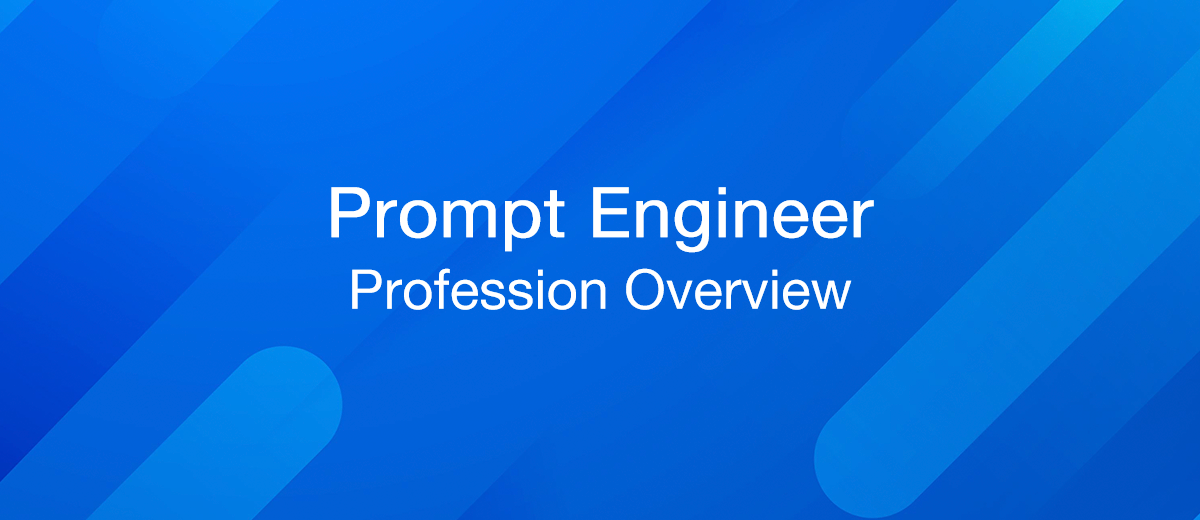Prompt Engineer: An Overview of the Promising Profession
With each passing year, artificial intelligence technologies are increasingly being applied in various areas and fields of human activity. The rapid development and spread of such innovations have led to the emergence of new professions and entire industries related to interaction with AI algorithms. One of the most renowned among them is the AI prompt engineer. Today, it piques the interest of a broad audience, attracting attention with its unusual job responsibilities and high salary. Given the high relevance of this topic, we have dedicated our article to it. You will learn what a prompt engineer does and why this profession is in such high demand right now. We will also share the skills required for it, the level of training, opportunities for career growth, and future prospects.
AI Prompt Engineering
An AI prompt engineer is a specialist engaged in the development, editing, and optimization of text prompts for artificial intelligence algorithms. As is known, most modern neural networks are controlled by special text commands, which are called queries or prompts. The more accurate the AI prompt is sent, the higher quality and more relevant result it will provide in response. Conversely, imprecise and vague phrases will hinder algorithms from understanding the essence of the request and providing the optimal answer.
Creating queries for artificial intelligence requires deep preparation and an understanding of AI principles. It would be naive to believe that such an activity is only slightly more complex than composing search prompts. In fact, it is meticulous and responsible work, as neural networks are currently at the initial stage of their development and their capabilities are still far from ideal. Considering this, prompt constructors have to invent and test many query options to achieve the desired result.
History of emergence and development
The emergence of the AI prompt engineer jobs was driven by the development of the GPT-2 and GPT-3 language models by OpenAI, which were trained on large volumes of text information using deep learning methods. In 2021, developers fine-tuned the generative neural network, enabling it to efficiently perform 12 tasks in the field of natural language processing (NLP) using 62 datasets. This version demonstrated high performance when solving new tasks and outperformed models that were trained to perform just one task without prior preparation. As of 2022, there were more than 2000 publicly available prompts for about 170 datasets in the repository.

With the release of
the ChatGPT chatbot, created based on the updated version of the GPT 3.5
language model, even broader prospects opened up for GPT 3 prompt engineering. Several training methods were used in
its development, including supervised and
reinforcement learning. This means that during the bot's training, special
trainer specialists interacted with it, playing out different models of
communication between the AI and the user and
correcting its answers using a series of sequential prompts. The language model constantly self-learned and retrained, following
constantly updated prompts. Trainers also evaluated its responses, using them
to create reward models.
In 2022, new AI models appeared, developed using machine learning (ML) technology: Midjourney, Stable Diffusion, and DALL-E 2. They stood out from their predecessors because of their ability to create images from text prompts. Along with their public launch, the need arose to create a new type of query related to text-to-picture conversion. In 2023, Meta released the Segment Anything AI model, built on computer vision technology. Developers endowed it with the ability to segment the image through prompts. The novelty supports three types of prompts: exclusion and inclusion points, bounding frames, and masks. Of course, the development of the field of prompt engineering, as well as artificial intelligence, does not end there. On the contrary, the most interesting part is just beginning.
Application areas
AI prompt engineering is not only a way to manage services with artificial intelligence support but also a tool for designing large language models (LLM), which allows training them based on specific prompts to obtain the necessary data output. It combines elements of logic, and programming and requires a certain level of creativity and, in some cases, the use of special modifiers.
As AI is applied in many industries today, prompt engineering will cover the same areas. Let's give a few examples:
- Text generation. Prompt engineers can create prompts for generating texts intended for different types of applications and services (chatbots, virtual assistants), as well as for creating content posted on web resources. They ensure the accuracy and relevance of the text and its compliance with the set of criteria presented to it.
- Formulating logical conclusions. Generative language models can summarize large articles, multipage documents, and even entire books. Properly developed prompts help them focus on the most significant information and concisely express it.
- Translations. Artificial intelligence can easily, quickly, and quite accurately translate texts from one language to another. Well-formulated prompts outline the correct context, improving the accuracy of the translation performed by the language model.
- Medicine. AI can perform an analysis of medical records, create a report, and, in some cases, even help a doctor make a clinical decision. A correct query ensures the receipt of the most accurate and, most importantly, clinically significant data.
- User support. Customer support services are increasingly using artificial intelligence to create chatbots and automate responses to frequently asked customer questions. Successful prompts help chatbots provide users with relevant, accurate, and useful information.
Demand for Prompt Engineers
Now that you know what is a prompt engineer, let's consider why this profession is in such demand now and where exactly it is needed. The scope of application of prompt engineering is wide; it is used by both developers and users of generative neural networks. By the way, this versatility, in particular, contributes to the high popularity of the AI prompt engineer jobs.
- Automate the work of an online store or landing
- Empower through integration
- Don't spend money on programmers and integrators
- Save time by automating routine tasks
Thanks to such a specialist, developer teams can refine and optimize the functionality of the AI algorithms they create, as well as eliminate identified deficiencies. This direction is no less in demand for creating specialized neural networks for industry companies or other customers. In this case, prompt engineering GPT3 or another language model's helps to adjust the AI to perform specific corporate tasks for the company itself or its clients. For example, a law firm might use a neural network for the automatic development of contracts with the necessary data for a specific query. To accomplish this task, the AI needs to be properly trained so that the result it provides meets the lawyers' requirements. The prompt engineer trains language models to interact with clients of different companies, helping them extract the necessary information from the knowledge base more quickly and accurately.
In addition, developers can use prompt engineering to combine examples of existing code and descriptions of the problems they solve. A correctly chosen prompt will allow interpreting the purpose and functions of the existing code to understand its operating principle and opportunities for improvement. In the case of text-to-image neural networks, prompt engineering helps to more accurately adjust the characteristics of the generated images. By skillfully composing prompts, one can ask the AI model to create graphics with specific parameters of resolution, style, perspective, aspect ratio, and so on.
How to Become a Prompt Engineer
Given the popularity and demand of the profession, the question of how to become an AI prompt engineer is understandably common today. We'll attempt to give a comprehensive answer. First, you need to have a certain level of preparation. The list of required skills is not too large yet. However, it should be noted that the profession has only recently emerged and is actively developing, so the volume of requirements may noticeably increase over time.
For successful work as an AI prompt engineer, you will need the following skills:
- Working with text. Unlike some other IT professions, AI prompt engineers need to be able to accurately, concisely, and clearly present information in written form to maximize interaction efficiency. Some neural networks require very detailed and extensive prompts consisting of hundreds or even thousands of carefully selected words.
- Programming. Although AI prompt engineering is not fully fledged coding, specialists in this field are often required to have programming knowledge. In some cases, they are directly involved in the development of the AI platform, or their programming skills are used for automation of testing and other functions. Often, knowledge of Python or other languages, as well as APIs, operating systems, and command-line interfaces, is listed as necessary skills for this profession.
- Experience in AI prompt engineering. Despite the profession's youthfulness, employers prefer applicants with at least minimal experience when looking for AI prompt engineers. Of course, it's almost impossible to find professionals with 3-5 years of experience in the labor market today. However, a candidate must have a clear understanding of the basic language models and the ability to create effective prompts and test them.
- Knowledge of AI. Understanding the principles of AI operation is another key requirement for those wishing to become an AI prompt engineer. The applicant needs to have a profound understanding of natural language processing (NLP), machine learning, and other artificial intelligence technologies. This is especially important if the specialist will also be involved in the development of generative neural networks.
- Data analysis. If you're interested in learning how to learn prompt engineering, first ensure you're confident working with data. You will need to understand the information provided to AI algorithms, used in prompts, and received in response from the neural network. This requires in-depth knowledge of methods and tools for analyzing structured and unstructured data, including Big Data.
As for soft skills, analytical thinking and the ability to quickly determine the optimal problem-solving approach are relevant for an AI prompt engineer. Moreover, it is crucial to possess effective communication skills and the ability to collaborate with other specialists within cross-functional teams.
Considering the youth of the profession, employers rarely require applicants to have specific certificates or diplomas to confirm their qualifications. It will be sufficient to have documents on education received in the field of computer science, engineering, or another related area.
Employment and Salary
Now that you've learned what prompt engineering is and what skills are needed to master this direction, it would be nice to understand the demand for this profession in the modern job market. Artificial intelligence technologies are actively being introduced in various sectors and industries, and along with them, the need for AI prompt engineers is steadily growing. Although this line of work has only recently emerged and is in the early stages of development, its prospects can already be noted. This specialty will provide rapid professional and career growth for those who have a creative mind and understand programming and neural networks.

Already today, prompt
engineers can offer their services in many areas, and over time, their demand will steadily grow. For example, news
agencies and other types of media actively hire such specialists for the
implementation and servicing of artificial intelligence models. It's no secret
that, in the near future, neural networks are highly likely
to replace journalists and other text authors. Therefore, the skills of a
prompt constructor will be in demand for setting up their algorithms and
managing them.
Among other promising areas for employment, the following can be noted:
- Legal firms that use AI for drafting and analyzing contracts and other documents.
- Companies that develop neural networks or apply them in their activities.
- Companies that sell AI-generated images, videos, and other content.
- E-commerce businesses or other fields that utilize neural networks for customer service and support.
- AI prompt marketplaces – creation of AI tips for sale on special platforms.
One of the key indicators of the demand for a profession is the level of salary its specialists receive. According to Bloomberg, the average annual AI prompt engineer salary in the US is in the range of $175,000 to $335,000. Factors that affect its size include experience, company location, and the industry to which its activities relate. Entry-level specialists can expect an income of between $70,000 and $90,000 per year. More experienced employees with tenure can expect to earn over $120,000 per year. The work of prompt engineers is valued even higher by top neural network providers. For example, the company Antropic posted a vacancy for an AI prompt engineer and librarian with a base annual salary of $250,000 to $335,000. The well-known company OpenAI, the developer of the chatbot ChatGPT, hires hundreds of engineers to develop and improve its platform and pays them $370,000 per year.
Prospects for the Profession in the Future
Prompt engineering ChatGPT and other commercial AI-based services, as well as the profession of prompt constructor, are very young and dynamically developing directions, so predicting their future is not easy. As for key trends, one can assume that the development scenario for this industry will be the same as for the entire IT industry. Thus, diversification, specialization, and standardization will likely become priority trends for it in the near future.
Neural network versions are quickly updated. For example, the recently released GPT 3.5 was swiftly succeeded by GPT 4, improved with new capabilities. OpenAI's competitors are not standing still either, launching their own chatbots. In the coming years, the market for smart chatbots will continue to expand, and other language models and AI-supported platforms will appear. Therefore, prompt constructors will have a large volume of work to train neural networks and implement them in various products.
Apix-Drive is a universal tool that will quickly streamline any workflow, freeing you from routine and possible financial losses. Try ApiX-Drive in action and see how useful it is for you personally. In the meantime, when you are setting up connections between systems, think about where you are investing your free time, because now you will have much more of it.


